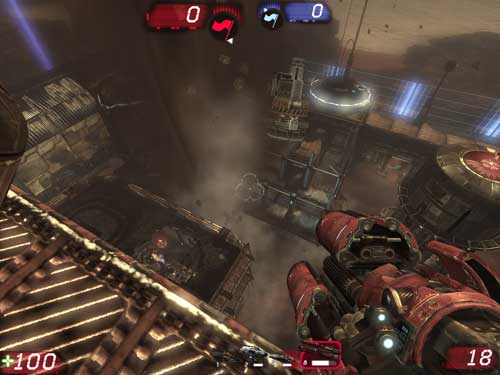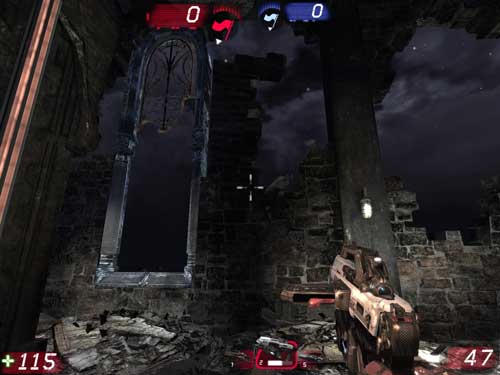PhysX’s Big Break? Unreal Tournament 3 PhysX Performance
by Ryan Smith on December 14, 2007 12:00 AM EST- Posted in
- GPUs
AGEIA’s Mod Pack & The Test
Unfortunately the PhysX situation in Unreal Tournament 3 is a little more convoluted than we would like. While the engine is capable of first-order physics using PhysX, because the game is not solely a technological showcase, there aren’t any maps that ship with it that heavily utilize physics interactions. The game does use the PhysX libraries to run some physical simulations, but other than a handful of situations such as cloth simulations, there isn’t much obvious physics work taking place. It’s not the eye-candy feasts that we’ve seen with other PhysX hardware enabled games, but this is also a benefit: UT3’s PhysX hardware support doesn’t enable any extra eye-candy, it solely offloads the physics work to the PPU. This will be an important distinction going forward as we’re going to be looking solely at issues of performance and not non-quantifiable (and performance-impairing) aspects of eye-candy.
AGEIA, apparently having taken charge of promoting PhysX on Unreal Engine 3, has been developing a mod kit to help modders/developers integrate physics situations in to their maps, and as a part of that kit has released a pair of maps that make heavy use of physical interactions as part of the gameplay. This makes UT3 straddle the line between being or not being a real/meaningful PhysX enabled game since as far as we know these are the only maps for the game that use first-order physics. This means that the biggest selling point for using a PhysX card with UT3 becomes the mod and not the game itself, but for the purpose of this article we’ll take the situation as it’s presented.
Along with our benchmarks of the shipping UT3 maps, we’ll include both of AGEIA’s mod maps in our benchmarks. The first map is CTF-Tornado, a map featuring a tornado that moves around unanchored objects, rips up some buildings, and sucks up unsuspecting players. As far as physical interactions goes this map is only moderately heavy, an intentional decision for allowing it to be playable without the PhysX PPU.
The second map is CTF-Lighthouse, AGEIA’s crown jewel out of their map pack, making very heavy use of physical interactions. This map features numerous destructible walls and floors, showcasing the direction AGEIA wants to push developers to go with physics. It’s also a pig of a map, as we’ll see it’s not playable at all without the PhysX PPU.
We’ve had to deviate a bit from our normal benchmarking routines, since UT3 does not support demo recording with AGEIA’s maps, presumably because of the first-order physics used. Instead we’ve gone with botmatches for all of our tests (including the normal UT3 maps) which offer variable results but also run the full client physics simulation process, ensuring that we’re capturing something fairly close to real world performance under repeatable circumstances. The use of bots means some CPU time is spent dealing with them, but given what we know about Unreal Tournament 2004’s player statistics, playing against bots turned out to be rather popular, so we don’t believe our results to be all that far fetched.
Every map we tested was run at 1600x1200 (our realistic scenario) and 800x600 (our anti-GPU bottlenecking scenario) both with the PhysX hardware enabled and disabled, on both a high-end QX6850 processor and a mid-range E6600. Varying all 3 processing components will allow us to reasonably isolate any bottlenecks in performance. All tests were run 3 times to reduce variability and the results averaged.
| Software Test Bed | |
| Processors | Intel Core 2 Quad QX6850 (3.00GHz/1333MHz) Intel Core 2 Duo E6600 (2.40GHz/1066MHz) |
| RAM | G.Skill DDR2-800 (2x2GB) |
| Motherboard | Gigabyte GA-P35-DR3R (Intel P35) |
| System Platform Drivers | Intel 8.1.1.1012 |
| Hard Drive | Maxtor MaXLine Pro 500GB SATA |
| Video Cards | 1 x GeForce 8800GTX |
| Video Drivers | NV ForceWare 169.12 |
| Power Supply | OCZ GameXStream 700W |
| Desktop Resolution | 1600x1200 |
| Operating Systems | Windows Vista Ultimate 64-Bit |












29 Comments
View All Comments
madgonad - Friday, December 14, 2007 - link
If most of the games arriving are enabled with this technology at a minimum it would give an equivalent boost of going from dual to quad core on regular maps using 2nd order physics. For games/maps using 1st order physics it would actually allow you to play them. For a $100 part (I have seen priced at $149) that might make sense if you have room in the case and PCIe 1x cards become available as a working product.For most of us, you know, people that build/buy a PC under a budget, this may or may not make sense. A physics processor may fall into the category of sound card since Vista and Realtek has taken great strides in making the previously mandatory sound card irrelevant. They might provide a couple "nice to have" features and slightly improve performance, but that money might be better spent on Crossfire or a faster CPU or better RAM or a mirrored hard disk.
The physics card is going to have to earn a place and this article does support that ability.
Heck, if it allows players to chew up the scenery I am all for it!
kilkennycat - Friday, December 14, 2007 - link
nVidia's upcoming dual-function next-gen silicon fully supporting either GPU or GPGPU functionality will finally kill PhysX. Wonder why the 780i chipset supports 3 PCIe16 slots and PCIe2.0? Think 2 GPUs in SLI dedicated to graphics and one GPU functioning as a GPGPU for bleeding-edge gaming. And for the less than bleeding-edge gaming, quad-core computation of bulk physics in combo with spare GPU horsepower for particle-effects will do quite nicely.Ryan Smith - Friday, December 14, 2007 - link
The funny thing is that at this time last year I'd agree with you, but now I'm not so sure.GPU physics has been a bust so far. ATI/NVIDIA made a bunch of noise when AGEIA announced their PPU, but HavokFX never came through and there is no other off-the-shelf solution that can do second-order physics, never mind first-order physics. It always seems like GPU physics in games is just around the corner and it never happens, and I'm not convinced that this misdirection from the GPU manufacturers is unintentional.
I keep hearing conflicting stories about when we'll get real GPU physics. Now the story is that things will finally be put in order forcefully by Microsoft in DirectX11, which is still years away (MS is still working on delivering DX10.1). This would coincide with some improvements in GPU threading that would help GPUs deal with the split workload, so it's very possible this is the case. Then again, both ATI and NVIDIA are finally delivering mature versions of their GPGPU programing environments (CUDA/CTM) which would allow someone to write a physics package at a lower level than shaders. I'm not aware of anyone working on this for games, though.
In the mean time the PPU does exist, and we expect we'll be seeing a far more powerful version fairly soon.
The 780i isn't the only chipset that supports 3 PCIe x16 slots either. I can show you some boards that came through here in 2005 that had the same support, for the exact same reason. Furthermore NVIDIA has a poor track record of supporting >2 GPUs in a system at once anyhow.
NickelPlate - Friday, December 14, 2007 - link
Let's hope so. The last thing PC gaming needs right now is another hardware requirement on the box.Martins - Friday, December 14, 2007 - link
So we don't need another Hardware requirement on the Box? In the form of a PPU that is $99 now and that as shown that can be faster them a $400+ dual core right? But you are not against the use of 3 or more GPU's and a new board if you want physics hardware acceleration, just do the math and see who gives us the best bung for ours money.NickelPlate - Friday, December 14, 2007 - link
I'm not saying their isn't a performance benefit. But the fact is PC gaming has slowly been taking the backseat to consoles over many years, mostly because it's getting more complicated and expensive for the average user. It's already depressing enough for most people to buy a high end graphics card only to have it chug on new games within years time. What's going to happen when they need a PPU upgrade every year also? Another $100? More? That's probably for the cheap ones. No doubt high end PPU cards will be end up costing hundreds.goku - Monday, December 17, 2007 - link
No, I think the problem is, pc gaming and well gaming in itself hasn't offered much innovation in a long time. A PPU would add a great amount of depth that is so sorely needed in today's games. What's the point of a high resolution tree if all you can do is cut it down in the same way as any other tree? Or how about driving a beautifully rendered car, but when you crash it, the damage is the same EVERYTIME.rykerabel - Wednesday, December 19, 2007 - link
wyrdI bought a physix just to put my money into encouraging some decent physics in the future.
I don't care which company succedes, i just want better physics period.
ChronoReverse - Friday, December 14, 2007 - link
Where are you getting this $400 dual core? Quad cores start at $279 now and dual cores can be had for less than $75 (soon even lower when the dual core Celerons come out).michal1980 - Friday, December 14, 2007 - link
I find that your statement of pc's not needed more new hardware just flat wrong.read the dailytech thread about display port. People are throughing themselves at a new port hand over fist. Those same people what physic's hard just because